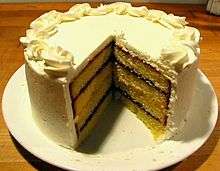Mille-feuille
The mille-feuille (French pronunciation: [mil fœj], "thousand-sheets"),[notes 1] vanilla slice or custard slice, similar to but slightly different[1] from the Napoleon, is a French pastry whose exact origin is unknown. Its modern form was influenced by improvements made by Marie-Antoine Carême.
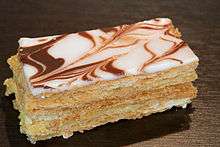 Mille-feuille | |
| Alternative names | gâteau de mille-feuilles, vanilla slice or custard slice, Napoleon pastry |
|---|---|
| Type | pastry, cake, pastry-cake |
| Main ingredients | Puff pastry, pastry cream, powdered sugar |
Traditionally, a mille-feuille is made up of three layers of puff pastry (pâte feuilletée), alternating with two layers of pastry cream (crème pâtissière). The top pastry layer is dusted with confectioner's sugar, and sometimes cocoa, pastry crumbs, or pulverized seeds (e.g. roasted almonds). Alternatively, the top is glazed with icing or fondant in alternating white (icing) and brown (chocolate) stripes, and combed.
History
All the elements of the recipe are present in numerous cookbooks since at least the 16th century but the exact origin of the mille-feuille is unknown. The earliest mention of the name mille-feuille itself appears in 1733 in an English-language cookbook written by French chef Vincent La Chapelle.[2] Unlike the modern cake, the 18th-century mille-feuille is served stuffed with jam and marmalade instead of cream.
In French, the first mention of the mille-feuille appears a little later, in 1749, in a cookbook by Menon.[3]
Menon, La science du maître d'hôtel cuisinier, avec des observations sur la connaissance & propriétés des alimens, 1749, p.367. Available online.
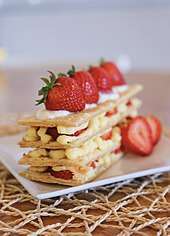
The word mille-feuille is not used again in the recipe books of the 18th century. However, under the reign of Napoleon Bonaparte, several of the fanciest Parisian pastry shops appear to have sold the cake.[4] During the 19th century, all recipes are filled with jam with the exception of the 1876 recipe by Urbain Dubois which is served with Bavarian cream.[5]
According to Alan Davidson in the Oxford Companion to Food (p. 505), the invention of the form (but not of the pastry itself) is usually attributed to Szeged, Hungary, where a caramel-coated mille-feuille is called Szegediner Torte.[6]
Composition
Traditionally, a mille-feuille is made up of three layers of puff pastry, and two layers of crème pâtissière. The top layer is coated with a sprinkling of powdered sugar.[7] In later variations, the top is glazed with icing, in alternating white (icing) and brown (chocolate) strips, and then combed. Today, there are also savory mille-feuille, with cheese and spinach or other savory fillings.
Variant names and forms
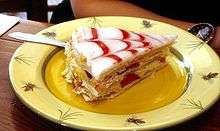
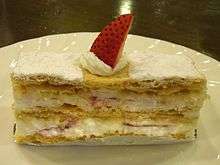
According to La Varenne, it was earlier called gâteau de mille-feuilles (English: cake of a thousand sheets), referring to the many layers of pastry. Using traditional puff pastry, made with six folds of three layers, it has 729 layers; with some modern recipes it may have as many as 2,048.[8]
The variant name of Napoleon appears to come from napolitain, the French adjective for the Italian city of Naples, but altered by association with the name of Emperor Napoleon I of France.[9] The Larousse Gastronomique does not mention the Napoléon, although a gateau napolitain is listed, with a note that while the cake itself is not often seen, small biscuits known as fonds napolitains are still made, decorated with butter cream or conserves.[10] There is no evidence to connect the pastry to the emperor himself. In France, a Napoléon is a specific type of mille-feuille filled with almond-flavored paste.[6]
.jpg)
In Russian literature, a cake named Napoleon (Russian: Наполеон) is first mentioned as early as in the first half of the 19th century.[11] Alexander Bestuzhev explained the emergence of such names by the romantic and historicist spirit of that time.[11] The cake has enjoyed an especially great popularity since the centenary celebration of the Russian victory over Napoleon in the Patriotic War of 1812. During the celebrations in 1912, triangular-shape pastries were sold resembling the bicorne. The many layers of the cake symbolized La Grande Armée. The top is covered by pastry crumbs symbolizing the snow of Russia which helped the Russians defeat Napoleon. Later, the cake became a standard dessert in the Soviet cuisine.[12] Nowadays, the Napoleon remains one of the most popular cakes in Russia and other post-Soviet countries. It typically has more layers than the French archetype, but the same height.
In Lithuanian tradition, Napoleon or Napoleonas is quite similar to Russian Napoleon. The recipe varies slightly as Lithuanians add layers of fruit filling such as apricots. It is often associated with weddings or celebrations and often given as gifts.
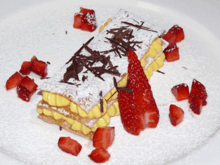
In Italy, it is called mille foglie and contains similar fillings. A savory Italian version consists of puff pastry filled with spinach, cheese or pesto, among other things. Another important distinction of the Italian variety is that it often consists of a layer of puff pastry with layers of sponge cake as well (e.g. from bottom to top, puff pastry, sponge cake strawberries and cream and then puff pastry).
In the United Kingdom, the pastry is most often called a vanilla slice, cream slice, or a custard slice, but can, on occasion, be named mille-feuille or Napoleon on branded products. It is common in the UK to only use two slices of pastry with a single, thick layer of filling between them.[13]
In Canada, mille-feuille is often named gâteaux Napoléon or Napoleon slice (in English Canada). It is sold either with custard, whipped cream, or both, between three layers of puff pastry; almond paste is the most common filling. There is a French Canadian way where the mille-feuille is made with graham crackers instead of puff pastry, and where pudding replaces the custard layer.
In South Africa and Zimbabwe, it is called a custard slice.
In Australia a variant is called a custard slice or a vanilla slice, colloquially, it is sometimes referred to as a snot block or puss pie. It is made using a gelatin-set crème pâtissière, and in many cases, passionfruit icing. "French Vanilla slice" refers to a product similar to that in the main article. In New Zealand it is variously known as a 'custard slice', a 'custard square', a 'vanilla slice', or, with passion-fruit icing, a 'passion-fruit slice'.
In the German speaking part of Switzerland and also in Austria it is called Crèmeschnitte. In Israel it is known by a variation of that name, kremshnit (קרמשניט).

In Poland, the local variant of the pastry is officially called napoleonka, and less commonly kremówka. It consists of two layers of pastry separated by a thick cream layer. The whole pastry is then covered with powdered sugar. A similar local variety is called krempita in Serbia and Bosnia and Herzegovina, kremna rezina or kremšnita in Slovenia and Croatia, and krémeš in Slovakia. In Hungary it is called krémes.[14] Its version francia krémes (French Napoleon) is topped with whipped cream and caramel.
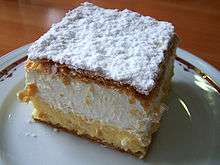
In Sweden as well as in Finland, the Napoleonbakelse (Napoleon pastry) is a mille-feuille filled with whipped cream, custard, and jam. The top of the pastry is glazed with icing and currant jelly. In Denmark it is called napoleonskage and in Norway napoleonskake, both meaning Napoleon cake.[15][16]
In Belgium and the Netherlands the tompouce or tompoes is the equivalent pastry. Several variations exist in Belgium, but in the Netherlands it has achieved an almost iconic status and the market allows preciously little variation in form, size, ingredients and colour (always two layers of pastry, nearly always pink glazing, but orange around national festivities). The cartoon character Tom Puss by Marten Toonder is named after the tompouce.
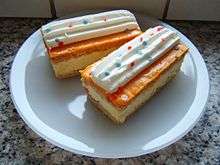
In Greece, the pastry is called μιλφέιγ, which is the transcription of the word mille-feuille using Greek letters. The filling between the layers is cream whereas Chantilly cream is used at the top of the pastry. It also has some resemblance to the traditional Greek dish of Galaktoboureko (literally "milk börek"), though with this dish, the custard is baked with the pastry, rather than added afterwards.
In the Spanish milhojas, the puff pastry is thin and crunchy. They are often far deeper than solely three layers of pastry and can reach up to .5 feet (0.15 m) tall.
In Latin American milhojas, various layers of puff pastry are layered with dulce de leche and confectioner's sugar on top. A Colombian version of milhoja has dulce de leche and melted bocadillo between the layers and is topped with whipped cream and coconut flakes.
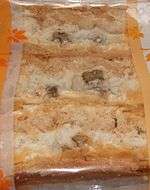
In Hong Kong, the 拿破侖 (naa4 po3 leon4, Napoleon) is layered with buttercream, meringue and walnuts. In Mainland China, a similar product also marketed as a Napoleon (拿破侖; Nápòlún, or more commonly, 法式千層酥) varies between regions and individual bakeries, but usually features a top and bottom layer of rough puff pastry, typically made with vegetable shortening rather than butter, and a sponge cake and artificial buttercream filling.
In Philippines, they are called napoleones (pronounced [na.pol.jɔ.nɛs], na-pol-yoh-nes; napoleón in the singular), and are made of two to three layers, with pastry cream or white custard as filling, topped with sugar glaze. It is a popular specialty on Negros Island, especially in Silay City, and can be bought as pasalubong by many who visit the island.
In Iran, the pastry is called شيرينى ناپلئونى (shirini-e Nâpel'oni, literally "Napoleonic sweet pastry"). It consists of thin puff pastry and often topped with powdered sugar.
In Morocco, Algeria and Tunisia, it is consumed regularly and is known by the French name mille-feuille. In northern Morocco they call it milfa which is a portmanteau of the words mille and feuille.
Notes
- The name is also written as millefeuille and mille feuille.
References
- Goldberg, Elyssa. "So Hot Right Now: Millefeuille, the Butteriest, Flakiest French Pastry". Bon Appetit.
- La Chapelle, Vincent (1733). The Modern Cook. London: N. Prevost. p. 20.
- Menon (1749). La science du maître d'hôtel cuisinier, avec des observations sur la connaissance & propriétés des alimens. p. 347 – via Bibliothèque nationale de France.
- Grimod de la Reynière (1810). Almanach des gourmands: servant de guide dans les moyens de faire ..., Volume 7. Joseph Chaumerot. p. 221. Retrieved 26 July 2016 – via Google Books.
- Dubois, Urbain (1876). Cuisine de tous les pays: études cosmopolites. p. 538 – via Google Books.
- Davidson, Alan; Jaine, Tom (1999). The Oxford Companion to Food. Oxford University Press. p. 505.
- "Mille-feuille". Larousse Cuisine. Retrieved 2016-03-11.
- André Guillot, Vraie Cuisine légère, Éditions Flammarion, 1992, republished in 2007 ISBN 978-2-08-202542-3 (in French). The counting of layers was reported in Compte-rendu du Séminaire n°32 de gastronomie moléculaire (December 18, 2003) from the French Society of Chemistry, see Compte-rendu Archived 2008-12-05 at the Wayback Machine (in French).
- Olver, Lynne. "history notes-pie & pastry". The Food Timeline. Retrieved 2016-03-11.
- Larousse gastronomique, p702; the mille-feuille is mentioned, page 667, and credited as a late 19th-century creation.
- «Вонзаете вилку в сладкий пирог и - его имя Наполеон!» из статьи «Клятва при гробе Господнем. Русская быль XV века. Сочинения Н. Полевого. 1832». А. А. Бестужев-Марлинский. 1833. (in Russian) -Stick a fork in a sweet cake, and its name is Napoleon! from the article Oath at the Holy Sepulchre. Russian true stories in the 15th century. Works by N. Polevoy. 1832. Alexander Bestuzhev. 1833.
- П. В. Абатуров; et al. (1955). М. О. Лифшиц (ed.). Кулинария. Москва: Госторгиздат, Министерство пищевой промышленности СССР. p. 763. (in Russian) - P. V. Abaturov; et al. (1955). M. O. Lifschitz (ed.). Cookery. Moscow: Gostorgizdat, USSR Ministry of Food Industry. p. 763.
- "Custard slice". BBC Food.
- "The Best Krémes in Budapest, Hungary". The Wall Street Journal. Retrieved 16 September 2015.
- napoleonskage, Ordbog over det danske sprog
- napoleonskake, Det Norske Akademis ordbok
